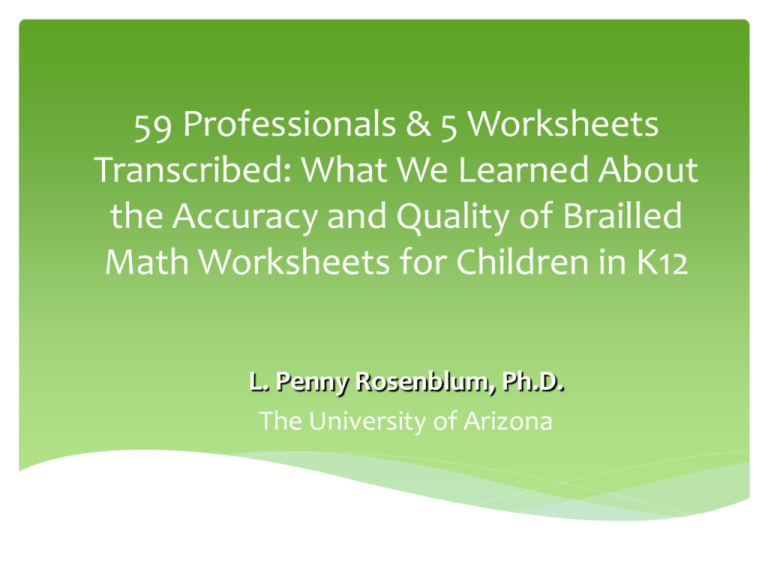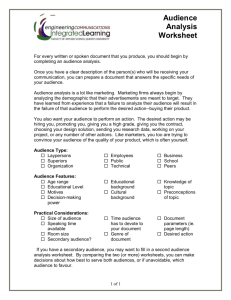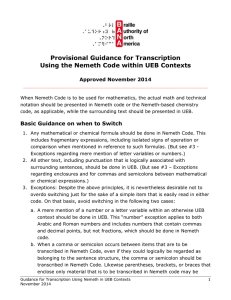Accuracy and Techniques in the Preparation of Math Worksheets for
advertisement

59 Professionals & 5 Worksheets Transcribed: What We Learned About the Accuracy and Quality of Brailled Math Worksheets for Children in K12 L. Penny Rosenblum, Ph.D. The University of Arizona G As We Walked the Beach at GITWL 2009 We Wondered… Who prepares math materials for learners who use braille and what are their qualifications? How are math materials prepared for learners who use braille? What is the quality of the math materials being prepared for learners who use braille? To Participate in the Study… Participants had to prepare math materials for students in grades K12 using Nemeth code. Participants had to prepare math materials within the last 3 years. Our Participants… Completed an on-line demographic survey Completed, in hard copy braille, at least one of five math worksheets 1st grade 3rd grade 5th grade Algebra Geometry Completed an on-line transcription survey Demographic Data are Reported in Rosenblum & Herzberg, 2011 Gender (n=166) 160 Female 6 Male Job Role (n=166) 80 TVIs 23 Transcribers & Paraprofessionals Years Preparing Math 46 Transcribers Braille Materials (n=166) 17 Paraprofessionals 37 1-3 years Quality of materials (n=162) 39 4-6 years 30 Excellent 31 7-10 years 109 Good 21 11-15 years 21 Fair 38 16+ years 2 Poor 1st Grade Worksheet (n = 32) Worksheet contains 27 single digit addition problems set up as a “game.” The first square on the game board says "START" and the last says "HOME FREE.” There is a "hint" box that says "Thinking Helps." Three pictures are on the game board that don't tie to the game. 3rd Grade Worksheet (n=22) A simple word problem Two digit addition spatially aligned problems A problem where the student has to mark a temperature on a thermometer A problem where the student shows time on a clock A problem where a square needs to be identified 5th Grade Worksheet (n = 21) This worksheet is titled “Triangles and Quadrilaterals” and contains 12 problems. The first 9 problems have shapes, and students must classify the shapes and/or find the missing angle. The final problem shows a flag and asks students to classify colored parts of it. Algebra Worksheet (n = 18) The title of this worksheet is “Skills Practice: Writing Equations in Slope-Intercept Form.” 3 problems contain graphs that show lines on a coordinate plane. For the other 8 problems students must write equations with the given information. Geometry Worksheet (n = 15) The title of the worksheet is “Geometry Practice.” Worksheet contains a title, directions, and six unnumbered problems. The first two problems require an understanding of rotation. The other four problems require the calculation of area and/or perimeter for trapezoids and triangles. Coding Categories Literary Nemeth Literary and Nemeth Formatting Tactile graphics, including labels and keys Transcriber’s Note Other Addition of material not on the worksheet Comments from the researcher(s) Miscellaneous Coding: Example of Data Collection forData Literary and Nemeth 3rd Grade Worksheet, . Thermometer 2. Shade the thermometer to show 43°F Included text of problem If problem reworded, how? How was 43⁰F brailled? Placement of first line of problem Placement of runover Number of literary & Nemeth errors Description of errors Coding: Example of Data CollectionData for Tactile Graphics 3rd Grade Worksheet, Included thermometer Thermometer Position of thermometer on page 2. Shade the thermometer to show 43°F. Outline of thermometer clear tactually Included labels Description of labels used Other degree markers included Accuracy of other degree markers Number of Nemeth errors Description of Nemeth errors Demographics of Worksheet Participants (n=59) Professional Role TVIs (n=18) Transcriber & Paraprofessionals (n = 9) Transcribers (n=22) Paraprofessional (n=10) NLS Certification Not certified (n=35) Certified (n=24) Certified literary only (n=17) Certified literary & Nemeth (n=5) Certified literary, Nemeth & textbooks (n=1) Certified literary & textbooks (n=1) Demographics of Worksheet Participants (n=59) Years Preparing Math Materials 1-3 years (n=10) 4-6 years (n=14) 7-10 years (n=12) 11-15 years (n=6) 16+ years (n=17) Hours Preparing Math Materials Per Week 1-5 hours (n=15) 6-10 hours (n=11) 11-15 hours (n=7) 16-20 hours (n=7) 21-25 hours (n=4) 26+ hours (n=5) Demographics of Worksheet Participants (n=59) Level of preparedness to produce math & science materials for tactile learners Got all of what needed to know through training (n=3) Some gaps in training that had to be filled in once work began (n=5) Many gaps in training that had to be filled in once work began (n=14) Learned most of what needed to know on the job (n=32) Participants’ Ratings of Their Skills Tactile Graphics Production Beginner (n=12) Intermediate (n=36) Advanced (n=10) Technology Beginner (n=7) Intermediate (n=38) Advanced (n=14) Tools Used 65% of the time braille translation software was used to prepare worksheets. Tool Perkins Brailler Braille Translation Software Other 1st Grade 3rd Grade 5th Grade Algebra Geometry (n=32) (n=22) (n=21) (n=18) (n=15) 10 3 2 3 1 22 19 19 14 12 0 0 0 1 0 Planning Time 80% of the time less than 15 minutes was spent in planning Time > 15 minutes 16-30 minutes 31-45 minutes 46-60 minutes 1st Grade 3rd Grade 5th Grade Algebra Geometry (n=32) (n=22) (n=21) (n=18) (n=14) 29 20 13 13 10 2 1 4 4 1 1 1 3 1 3 0 0 1 0 0 Production Time 54% of the time less than 30 minutes was spent in production Minutes 1st Grade (n=32) 3rd Grade 5th Grade Algebra Geometry (n=22) (n=21) (n=18) (n=14) > 15 17 4 7 3 1 16-30 9 7 3 4 3 31-45 3 7 4 5 4 46-60 3 1 3 1 2 61+ 0 3 4 5 4 Sources for the Rules on the Following Slides Braille Authority of North America (2011). Braille formats Principles of print-to-braille transcription. Retrieved from http://www.brailleauthority.org/formats/2011manualweb/index.html Braille Authority of North America (2010). Guidelines and standards for tactile graphics. Retrieved from http://www.brailleauthority.org/tg/web-manual/index.html Laudenslager, E. . (1972). The Nemeth braille code for mathematics and science notation. Louisville, KY: American Printing House for the Blind. Formatting: Braille Page Numbers 70 of 107 worksheets included braille page numbers 76% of the time braille page numbers were on all pages 46% of the time braille page numbers were on the top right / 54% of the time on the bottom right 97% of the time literary numbers were used 97% of the time braille page numbers were 1, 2, 3… Formatting: Print Page Numbers 5th grade worksheet only one with print page numbers 9 out of 21 participants included print page numbers 9 out of 9 participants put the print page number in the top right corner 8 out of 9 participants used literary numbers Formatting: Bolding, Underlining & Italics In almost all instances bolding, underlining & italics was stylistic 85% of the time when the bolding, underlining & italics was stylistic, it was omitted 3rd grade worksheet: “Show 3:45 on the clock.” 1 out of 15 used an emphasis indicator 5th grade worksheet: “Fill in each blank with always, sometimes, or never.” 10 out of 21 used an emphasis indicator Formatting: Headings Rules: center the title, leave a blank line above and below the title, capitalize as in the ink print 102 out of 107 worksheets included a title 57% of the included titles were centered 94% of the time capitalization was followed 84% of the titles were followed by a blank line On 24 out of 26 of the worksheets where name/date was brailled prior to the title, a blank line was left Formatting: Directions Included on the 5th grade, algebra and geometry worksheets Example: Write an equation of the line that has each pair of intercepts. Rule: Directions are to begin in cell 5 with runover in cell 3 46% of the time directions began in cell 5 Most common error was to begin in cell 1 54% of the time runover began in cell 3 Most common error was to begin in cell 1 Formatting: Numbered Exercises Included on the 3rd, 5th, and algebra worksheets Example: 7. Write a direct variation equation assuming y varies directly as x if y =10 when x = -2. Find x if y = 30. Rule: Numbered exercises begin in cell 1 with runover in cell 3 87% of the time numbered exercises began in cell 1 56% of the time runover began in cell 3 Formatting: Placement of Subdivisions Rule: Main division numbers or letters begin in cell 1 with runover in cell 5. 100% of the time began in cell 1 33% of the time runover in cell 5 Rule: Subdivision numbers or letters begin in cell 3 with runover in cell 5. 57% of the time began in cell 3 33% of the time began in cell 5 Literary Example: Calculate the area of the trapezoid. 94% of literary material was transcribed correctly Common errors: Misspelling words such as calculate, many, and quadrilaterals Not using part-word signs in words (e.g., ful in carefully, ch in each) Adding and omitting words and punctuation such as the period and semi-colon Nemeth Example: 4. (1, 9), m = 4 93% of Nemeth material was transcribed correctly Common errors: Using literary numbers instead of Nemeth numbers Not using the punctuation indicator between a number and the period when numbering problems Using the literary sign instead of the Nemeth sign for the hollow dot indicating degrees. 91% of the time the 4 cell dash was used to show omitted materials when a print dash was used. Literary and Nemeth Example: How many toes do 9 children have all together? 87% of Literary & Nemeth material was transcribed correctly Errors included: Using literary numbers instead of Nemeth numbers Misspelled words such as parallelogram Not using a punctuation indicator between a number and mark of punctuation Misconfigured letters such as the letter o in toes and w in draw Omitting words and punctuation such as a period. Transcriber’s Note Few TNs were used across the transcriptions 99.3% of the TNs did not have errors within the text 58% of the time the opening & closing TN symbol was transcribed correctly 1st grade worksheet 6 TNs all before the problems None used the recommended “Ask your teacher for help.” 3rd grade worksheet 21 TNS each placed with one of the graphics (e.g., clock, thermometer) 5th grade worksheet had 6 TNs Algebra worksheet had 1 TN Geometry worksheet had 3 TNs Most TNs told location of material. Tactile Graphics: Inclusion & Placement 89% of the time the tactile graphics had the same orientation as in the inkprint 27% of the time the tactile graphics were placed on a separate page Placement on the page, most common: 19% of the time on the left 40% of the time centered Tactile Graphics: Elements 84% of the time elements were included 100% of the time elements were positioned as inkprint 89% of the time all elements could clearly be felt 94% of the time all labels included 91% of the time labels were not too close to other elements Angle measures 37% inside the shape 35% outside the shape 14% of the time some were inside and some were outside the shape 12% of the time labels were omitted 1st Grade Worksheet (n=32) 5 out of 32 participants set up as a game board BANA (2010) says “make it fun” No participants included the 3 pictures 13 included “box contents” at top / 12 at bottom / 7 omitted 6 participants put all problems in linear format 15 double spaced problems Boxed Material THINKING HELPS: • “1 more” or “1 less” than 10 • Share TVIs (n=9) Before problems Following problems (location in print copy) Omit completely 56% (n=5) 11% (n=1) 33% (n=3) Trans. Trans. & Paras. (n=17) Paras. (n=6) (n=8) 43% (n=3) 57% (n=4) 17% (n=1) 68% (n=4) - - 50 (n=4) 37% (n=3) 13% (n=1) 3rd Grade Worksheet (n=22) Variability in what part of the title was included 21 participants showed the ice cream cones in groups of 4. 20 participants placed the ice cream symbol before the 12 ice cream cones were shown. Numbers on the Thermometer and Clock TVIs (n=18) Trans. (n=22) Trans. & Paras. (n=9) Paras. (n=10) Omitted NI when labeling thermometer 0% (n=6) 10% (n=10) 0% (n=2) 25% (n=4) Omitted NI when labeling clock 66.7% (n=6) 60% (n=10) 50% (n=2) 75% (n=3) How do you braille… Shade the thermometer to show 43°F. (ELI)(cap)(F)(.) (cap)(F)(.) (cap)(F)(PI)(.) Other TVIs Trans. Trans. & (n=6) (n=10) Paras. (n=1) 16.7% 30% (n=1) (n=3) 16.7% 30% (n=1) (n=3) 50% 40% (n=3) (n=4) 100% (n=1) Paras. (n=4) 25% (n=1) 50% (n=2) 25% (n=1) - Flag All participants included the flag and positioned it properly with clear lines between 3 regions. 18 of 21 participants had 3 regions that were tactually different. 14 of 21 did not use a key. Of the 7 using a key 5 placed it above the flag, one below the flag and one to the left of the flag. 5 individuals used a lead line from label (e.g. red) to region. Algebra Worksheet (n=18) 16 participants who included the 3 graphs included the x-axis and yaxis. The 16 participants had xaxis and y-axis that were tactually clear. For the 16 participants the points on the line (e.g., -1, 4) were tactually clear. Brailling the Origin It seems unclear if the origin is labeled a zero or letter O in print. Number 0 (zero) Letter o TVIs (n=6) 50% (n=3) 50% (n=3) Trans. Trans. & Paras. (n=9) Paras. (n=3) (n=6) 33% 67% 100% (n=3) (n=2) (n=6) 66% 33% (n=6) (n=1) According to Guidelines and Standards for Tactile Graphics, if the origin cannot be determined in print and there are no numbers on the axes, then label the origin as the letter O. Geometry Worksheet (n=15) 12 out of 15 participants included the grid lines on the graphs. All participants included the dashed lines, and in 12 instances they could easily be felt tactually. All 15 participants included the right angles. Other Items Noticed During Data Entry Some spatial problems transcribed as linear problems. Order of problems on game board – most followed order of the problems on the game board, but some did not. They went row by row instead. There was great variation in what was used as the title of the worksheets. Some participants did not follow capitalization of the print. There was great variation in the lengths of lines and sizes of shapes on graphics. Some took an entire page for a simple graphic, and others placed 2-9 simple graphics on a page. A Few More Things Our Participants Shared… 45 almost always proofread their work. 25 out of 59 never have someone proofread their work, and 17 do so on rare occasions. 36 out of 59 sometimes feel they need additional support or information. 10 felt they produced excellent quality science and math materials; 41 felt they produced good quality materials; 7 felt they produced fair quality materials. What Are Our Future Plans? Completion of a second article for JVIB Study with youth to gain information about their experiences Development of a workshop, on-line course, or other vehicle for professionals Continued exploration of what we need to be teaching pre-service TVIs and other individuals preparing math & science materials for braille users We would love to hear from You! Dr. L. Penny Rosenblum rosenblu@u.arizona.edu 520-621-1223 Dr. Tina Herzberg therzberg@uscupstate.edu 864-503-5572




